Topics 2016
December 2016
Dec. 20, 2016 Updated
Success of Epsilon-2 Launch with ERG Aboard
|
JAXA successfully launched the second Epsilon Launch Vehicle with Exploration of energization and Radiation in Geospace (ERG) aboard at 8:00 p.m. on December 20, 2016 (JST) from the Uchinoura Space Center. The launch vehicle flew as planned, and at approximately 13 minutes and 27 seconds after liftoff, the separation of ERG was confirmed. The signals were received in the Santiago Ground Station, the Republic of Chile at 8:37 p.m. (JST). ERG's solar array paddles have been deployed as planned.
Also, ERG has completed the attitude control based on the sun acquisition. |
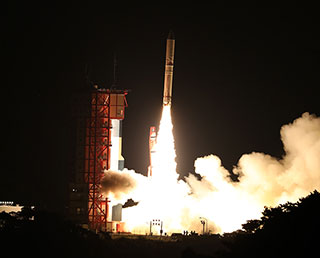
|
|---|
Dec. 19, 2016 Updated
Epsilon-2/ERG launch time decided! Live broadcast from 7:40 p.m. on December 20 (Tue.)
|
The launch time of the second Epsilon Launch Vehicle with Exploration of energization and Radiation in Geospace (ERG) was set for 8:00:00 on December 20 (Tue.), 2016 (Japan Standard Time). |
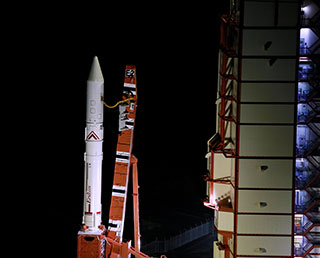
|
|---|
Dec. 14, 2016 Updated
KOUNOTORI6 berthed at ISS!
|
The cargo transporter to the International Space Station, KOUNOTORI6 (HTV6) was captured with the robotic arm of the International Space Station (ISS) at 7:39 p.m. on December 13 (Japan Standard Time) and berthed to the ISS at 3:24 a.m. on December 14 (JST). The KOUNOTORI6 was launched by the H-IIB Launch Vehicle No.6 on December 9. |
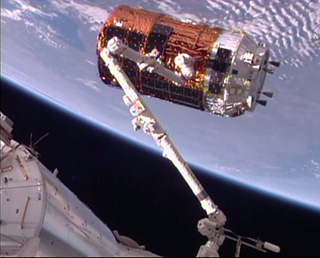
|
|---|
Dec. 10, 2016 Updated
KOUNOTORI6/H-IIB F6 Successfully Launched
|
The H-IIB Launch Vehicle No. 6 with cargo transporter to the International Space Station, the KOUNOTORI6 (HTV6) aboard lifted off from the Tanegashima Space Center at 22:26:47 on December 9. (Japan Standard Time) |
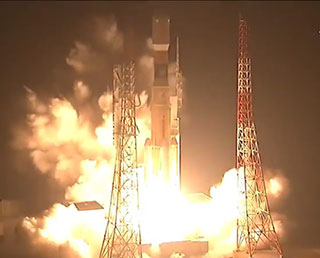
|
|---|
Dec. 8, 2016 Updated
KOUNOTORI6/H-IIB F6 launch time decided! Live broadcast from 9:35 p.m. on December 9 (Fri.)
|
The launch time of the H-IIB Launch Vehicle No. 6 with the KOUNOTORI6 (HTV6, a cargo transporter to the International Space Station) was set for 10:26:47 p.m. on December 9 (Fri.), 2016 (Japan Standard Time.) |
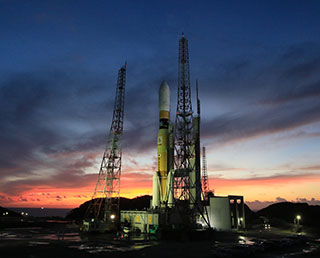
|
|---|
November 2016
Nov. 15, 2016 Updated
The Launch date of the Epsilon-2 with the ERG satellite on board- December 20
|
JAXA announced that the second Epsilon Launch Vehicle with Exploration of energization and Radiation in Geospace (ERG) on board will be launched sometime between 8 p.m. and 9 p.m. on December 20, 2016 (Japan Standard Time). Live launch coverage from the Uchinoura Space Center will be carried on YouTube. More detail will be available shortly. |
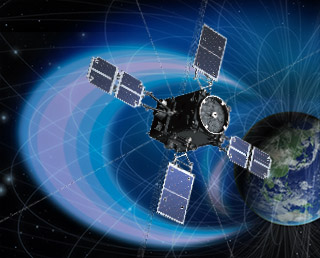
|
|---|
Nov. 2, 2016 Updated
"Himawari-9" lifted off for space! Launch Success of H-IIA F31.
|
The H-IIA Launch Vehicle No. 31 with the Geostationary Meteorological Satellite "Himawari-9" onboard lifted off at 3:20 p.m. on November 2, 2016 (Japan Standard Time) from the Tanegashima Space Center. |

|
|---|
October 2016
Oct. 31, 2016 Updated
New launch date and time of Himawari-9/H-IIA F31 decided
|
The Himawari-9/H-IIA F31 launch was postponed to 3:20:00 p.m. on November 2 due to adverse weather. The launch was originally scheduled for November 1. |
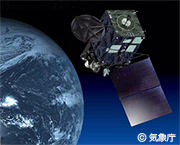
|
|---|
Oct. 30, 2016 Updated
"Welcome home Astronaut Onishi!" Safe return to Earth
|
At 0:58 p.m. on October 30 (Sun., Japan Standard Time), Astronaut Onishi came back to the Earth safely on the Soyuz spacecraft (47S), which successfully landed in the Republic of Kazakhstan. |
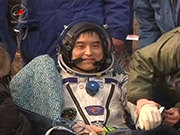
|
|---|
Oct. 27, 2016 Updated
Astronaut Onishi returning to Earth on Oct. 30 (JST)!
|
Astronaut Onishi is returning to the Earth at around 12:59 p.m. on October 30 (JST) after completing his long stay at the International Space Station for about four months. |
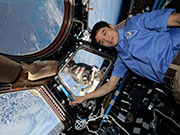
|
|---|
Oct. 7, 2016 Updated
Launch Schedule of “KOUNOTORI6” (HTV6) Updated to December 9
|
The launch schedule of the H-IIB Launch Vehicle No. 6 with the H-II Transfer Vehicle “KOUNOTORI6” (HTV6) on board, temporarily postponed has been updated to around 10:26 p.m. on December 9 (Fri.), (Japan Standard Time, JST). |
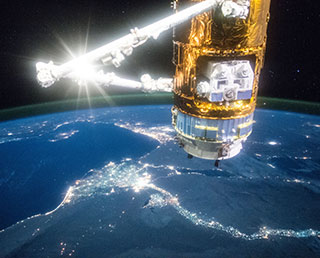
|
|---|
September 2016
Sep. 27, 2016 Updated
UNOOSA and JAXA open second round of KiboCUBE
|
JAXA and the United Nations Office for Outer Space Affairs (UNOOSA) launched a three year “KiboCUBE” programme in September 2015, which offered developing countries the opportunity to deploy cube satellites from the Japanese Experiment Module “Kibo” on the International Space Station (ISS). |
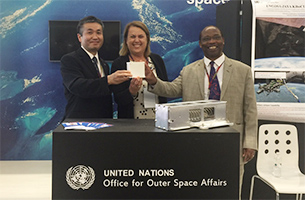
|
|---|
Sep. 26, 2016 Updated
Full release of the SELENE (KAGUYA) High Definition Television (HDTV) data
|
All the data taken by the high definition television (HDTV) onboard the SELENE (KAGUYA) lunar orbiter have been released. The SELENE HDTV, developed in cooperation with JAXA and NHK, captured the full HD images all around the Moon. The raw data, extracted right from more than 600 HD images that the SELENE HDTV acquired over the period of 21 months, are now available as they are of high scientific value.
|

|
|---|
Sep. 2, 2016 Updated
H-IIA F31 with Himawari-9 onboard to be launched on Nov. 1
|
The launch schedule of the H-IIA Launch Vehicle No. 31 (H-IIA F31) has been decided to be between 3:20 thru 6:18 p.m. on Nov. 1 (Tue), 2016 (Japan Standard time). The launch will be performed by Mitsubishi Heavy Industries and JAXA. |
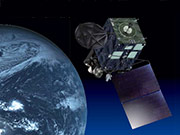
|
|---|
August 2016
Aug. 25, 2016 Updated
University of Nairobi team selected for UNOOSA-JAXA KiboCUBE project
|
The United Nations Office for Outer Space Affairs (UNOOSA) and JAXA have selected a team from the University of Nairobi to be the first to benefit from the UNOOSA-JAXA KiboCUBE programme. |
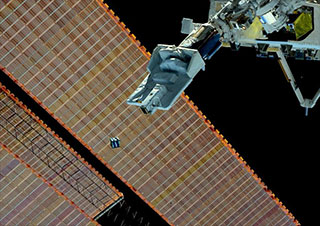
|
|---|
Aug. 10, 2016 Updated
Launch Postponement of “KOUNOTORI6” (HTV6)
|
Mitsubishi Heavy Industries, Ltd. and JAXA decided to postpone the launch of the H-IIB Launch Vehicle No. 6 with “KOUNOTORI6” (HTV6) onboard which was scheduled for October 1 (Sat.), 2016 (Japan Standard Time), as unfavorable.
|
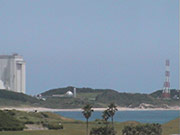
|
|---|
July 2016
Jul. 26, 2016 Updated
Launch day set for KOUNOTORI6/H-IIB F6!
|
The launch date and time for the H-IIB Launch Vehicle No. 6 (H-IIB F6) with the H-II Transfer Vehicle "KOUNOTORI6" (HTV6) onboard was set for around 2:16 a.m. on October 1 (Sat.), 2016 (Japan Standard Time). |
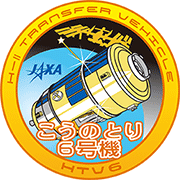
|
|---|
Jul. 9, 2016 Updated
Astronaut Onishi began his long-term stay at ISS
|
The Soyuz Spacecraft with Astronaut Takuya Onishi onboard lifted off at 10:36 a.m. on July.7 (Thu., Japan Standard Time,) and docked with the International Space Station (ISS) on July.9 (Sat). After the hatch to the ISS opened at 3:53 p.m., His first long-term stay there has started. |
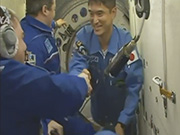
|
|---|
Jul. 7, 2016 Updated
Soyuz launched with Astronaut Onishi onboard
|
The Soyuz spacecraft with Astronaut Takuya Onishi aboard was launched from the Baikonur Cosmodrome (Republic of Kazakhstan) at 10:36 a.m. on July 7 (Japan Standard time.) The Soyuz will dock with the International Space Station on July 9 (Sat.) JAXA will broadcast a live report of the Soyuz crew including Astronaut Onishi entering the ISS from 3:00 pm on July 9. Please watch it! |
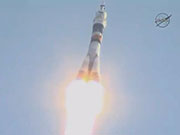
|
|---|
Jul. 7, 2016 Updated
An Unexpectedly Calm Hot Gas in the Center of the Perseus Cluster
|
An international team observed the hot gas in the Perseus cluster with the Soft X-ray Spectrometer (SXS) on board the X-ray Astronomy Satellite ASTRO-H ("Hitomi") during its initial operation phase, which started one week after liftoff. The total integration time was 230,000 s. |
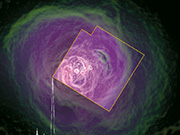
|
|---|
June 2016
Jun. 24, 2016 Updated
Astronaut Onishi leaving for space on July 7!
|
The Soyuz spacecraft carrying Astronaut Takuya Onishi is scheduled for launch at 10:36 a.m. on July 7 (Japan Standard Time.) JAXA will broadcast his departure and entering to the ISS live via YouTube. Please witness them!
|
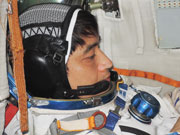
|
|---|
Jun. 7, 2016 Updated
New Launch Schedule for Astronaut Onishi
|
Roscosmos State Corporation for Space Activities announced on June 6 (Moscow Time) that it will postpone the launch of the Soyuz Spacecraft (47S/MS-01), on which Astronaut Onishi will be aboard. The new target launch date is 10:36 a.m. on July 7, and the date will be finalized and announced after coordinating with partners of the ISS. |
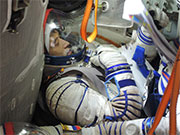
|
|---|
May 2016
May 13, 2016 Updated
Astronaut Onishi under training for target launch date of June 24
|
Astronaut Onishi continues his training for the final test to be aboard the Soyuz spacecraft (47S) at the Gagarin Cosmonauts Training Center (GCTC) in Russia. The Soyuz spacecraft, which Astronaut Onishi will
be aboard, is under preparation targeting the following launch date and time. |
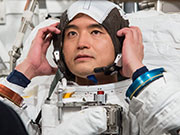
|
|---|
April 2016
Apr. 28, 2016 Updated
AKATSUKI onboard instruments to move to regular operation
|
JAXA decided to shift the operation mode of the five onboard instruments
of AKATSUKI to the regular operation mode, namely 1μm camera (IR1), 2μm
camera (IR2), Longwave IR camera (LIR), Ultraviolet image (UVI), and
Ultra-stable Oscillator (USO). |
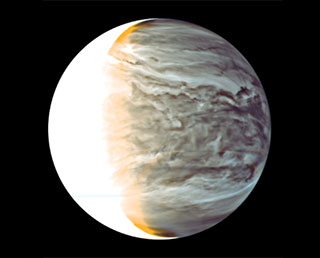
|
|---|
Apr. 28, 2016 Updated
Operation Plan of ASTRO-H (Hitomi)
|
JAXA established the emergency headquarters and has been doing its utmost to understand the anomaly of ASTRO-H (“Hitomi”). We have made every effort to confirm the status of ASTRO-H and to regain its functions. Unfortunately, based on our rigorous technical investigation, we had to conclude. JAXA have determined that we cannot restore the ASTRO-H’s functions.
Accordingly, JAXA will cease the efforts to restore ASTRO-H and will focus on the investigation of anomaly causes. We will carefully review all phases from design, manufacturing, verification, and operations to identify the causes that may have led to this anomaly including background factors. |
Apr. 27, 2016 Updated
Congratulations! The 1st Philippines microsat "DIWATA-1" deployed from Kibo/ISS
|
JAXA, Tohoku University, Hokkaido University, the Department of Science and Technology (DOST) of the Republic of the Philippines, and the University of the Philippines Diliman, successfully deployed “DIWATA-1,” the first Philippines microsatellite, from ISS/Kibo at 8:45 p.m. on April 27 (JST).
|
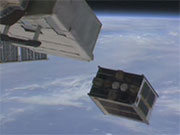
|
|---|
Apr. 27, 2016 Updated
Live broadcast of the Philippine satellite DIWATA-1 release from “Kibo” Japanese Experiment Module
|
A small Philippine's 50-kg class Microsatellite "DIWATA-1" is scheduled to be deployed by the Kibo's Small Satellite Orbital Deployer on April 27 (Wed., JST). This is the first attempt to deploy a 50-kg class satellite by the Japanese system.
|
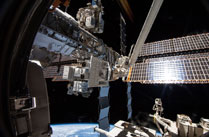
|
|---|
Apr. 25, 2016 Updated
Astronaut Onishi’s ISS Expedition comes closer
|
Astronaut Onishi will go to space as a crew member of ISS Expedition 48/49 from June 2016 for his first ISS long stay mission. His trip will further strengthen Japan’s reliability as a member of the ISS project. |
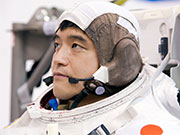
|
|---|
March 2016
Mar. 29, 2016 Updated
Current Hitomi Status
|
JAXA was not able to receive signals from the X-ray Astronomy Satellite "Hitomi" (ASTRO-H) when the operation started (at around 4:40 p.m.) on March 26, 2016, and we have not been able to confirm the satellite status since then. JAXA is doing its utmost to restore communications with the satellite while investigating the cause with the help of the project team and other staff members. |
February 2016
Feb. 29, 2016 Updated
Hitomi critical operation phase successfully completed!
|
JAXA confirmed the completion of a sequence of important operations of the X-ray Astronomy Satellite “Hitomi” (ASTRO-H), including turning the cooling system on, test operation of the Soft X-ray Spectrometer (SXS), and extending the Extensible Optical Bench (EOB). With this confirmation, the critical operation phase of Hitomi was completed.
|

|
|---|
Feb. 25, 2016 Updated
Let Geospace satellite “ERG” carry your support message!
|
We are inviting you to have your message travel on the ERG satellite to explore the Van Allen belts, which is the last frontier in space around the Earth. * The call for application was closed. Thank you ! |
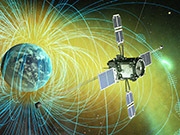
|
|---|
Feb. 17, 2016 Updated
ASTRO-H successfully launched and named "Hitomi"
|
H-IIA F30 with the "ASTRO-H" onboard launched at 5:45 p.m. on Feb 17, 2016 (JST) from the Tanegashima Space Center.
The rocket flew smoothly, and, at about 14 minutes after liftoff, "ASTRO-H" was separated from the H-IIA F30. |
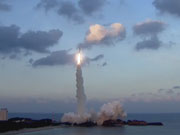
|
|---|
Feb. 14, 2016 Updated
ASTRO-H Launch rescheduled to 5:45 p.m. on Feb 17 (Wed., JST)
|
The launch of the The X-ray Astronomy Satellite "ASTRO-H" by the H-IIA Launch Vehicle No. 30 was rescheduled at 5:45 p.m. on Feb 17 (Wed. Japan Standard Time, JST) after carefully studying the weather conditions. |
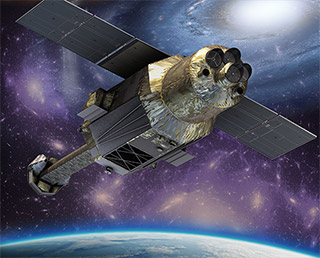
|
|---|
Feb. 12, 2016 Updated
The X-ray Astronomy Satellite "ASTRO-H" launch postponement
|
H-IIA Launch Vehicle No.30 with the X-ray Astronomy Satellite "ASTRO-H" onboard, which was originally scheduled for February 12 (Fri.), 2016 (Japan Standard Time), has been rescheduled because bad weather is expected. The new launch day will be announced as soon as it is determined. Your warm support messages are welcomed at the support site. |
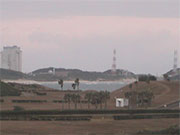
|
|---|
January 2016
Jan. 6, 2016 Updated
APRSAF-22 successfully held in Bali, Indonesia
|
The 22nd session of the Asia-Pacific Regional Space Agency Forum (APRSAF-22) was successfully held from December 1 to 4, 2015 in Bali, Indonesia, jointly organized by the Ministry of Research, Technology and Higher Education of Indonesia(RISTEK-DIKTI), the National Institute of Aeronautics and Space of Indonesia (LAPAN), the Ministry of Education, Culture, Sports, Science and Technology of Japan (MEXT) and the Japan Aerospace Exploration Agency (JAXA).
|

|
|---|